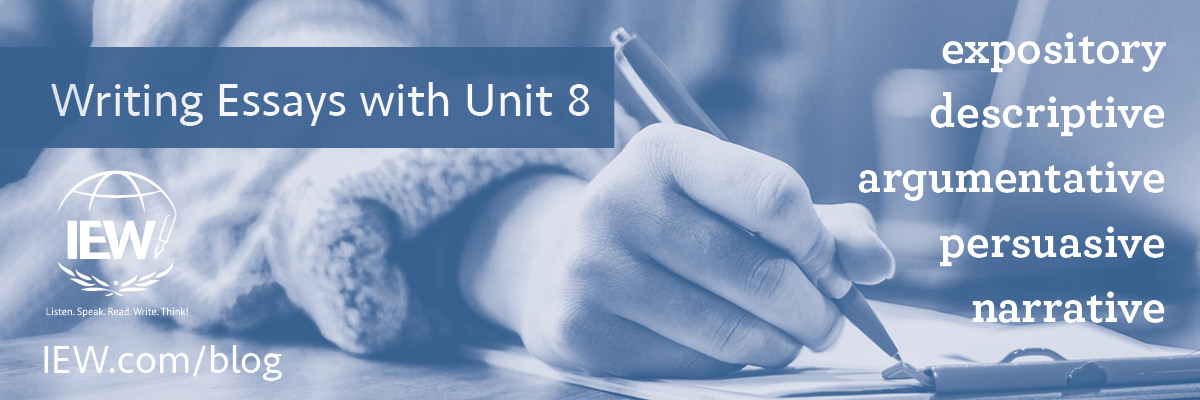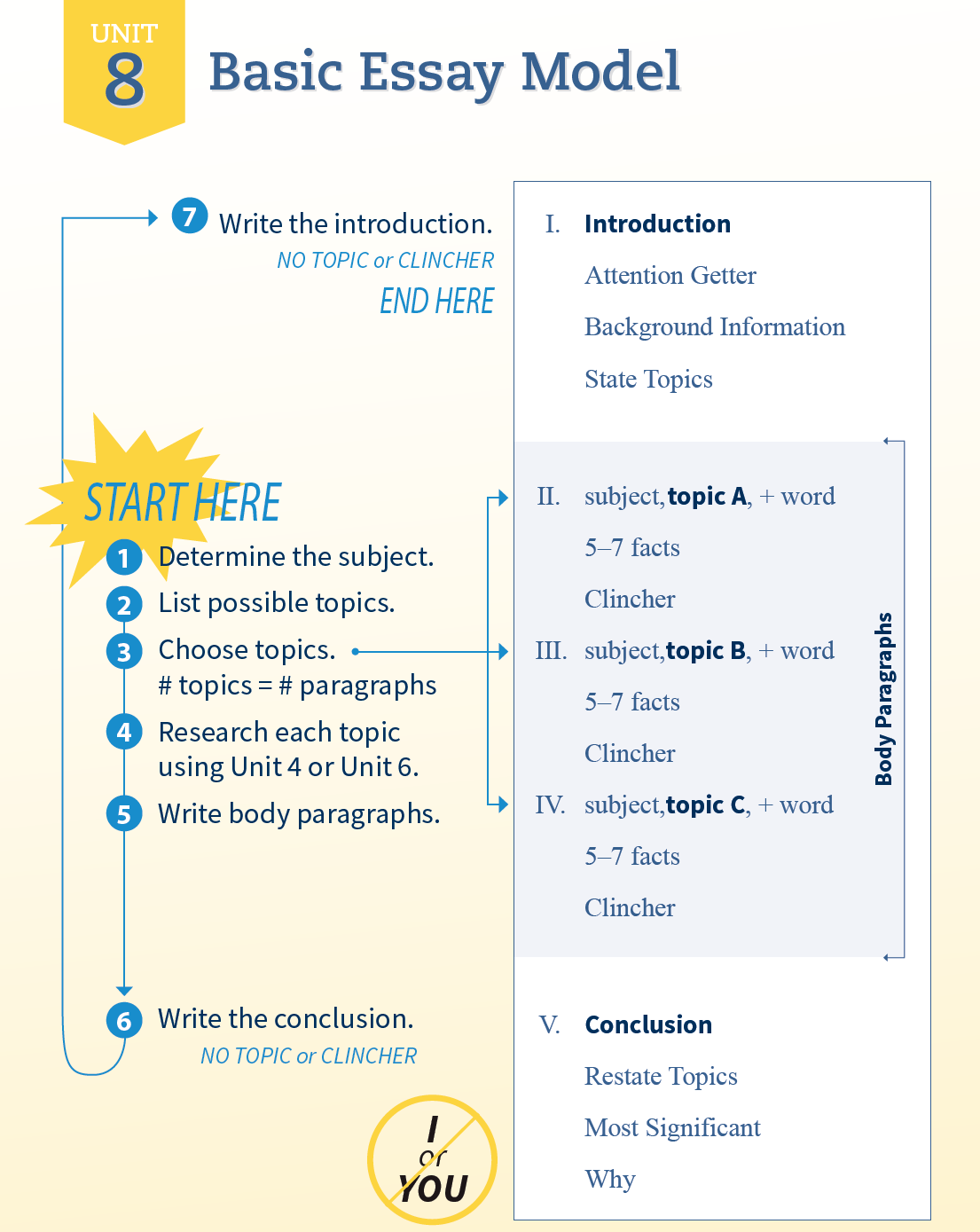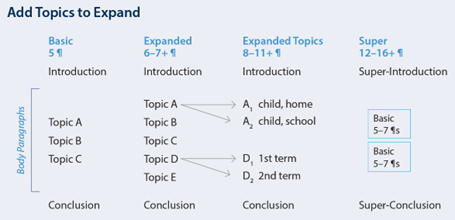
IEW teaches students to write with structure and with style. Style includes vocabulary. Structure is the elements found in compositions. Throughout the year students progress through nine structural units.
At this point in the blog series, we have covered Unit 1 through Unit 7. In Unit 7 students learned the structure of introductory and concluding paragraphs.
In Unit 8 students write various types of essays—expository, descriptive, argumentative, persuasive, narrative, and personal. An essay is a short, written composition that expresses the ideas, beliefs, or opinions of the author. The structure for the basic essay is the same as the 5-paragraph model learned in Unit 7.
Initially, students begin with a completed Unit 4 or Unit 6 assignment that includes two or three topic-based paragraphs about a single subject. These paragraphs are based on research found in one or more sources. By adding a conclusion and an introduction, students transform the paragraphs they wrote earlier in the year into an expository essay. As students write essays, teach them how to document quotations and how to write both bibliographies and works cited pages.
Students write additional essays by following a defined process.
- Determine the subject.
All writing assignments begin with the subject, the thing the essay is about. - List possible topics.
A topic is a division of or thing within the subject. Since an expository essay is researched based, students must find resources related to the subject. Resources include books, magazine or journal articles, encyclopedias, documentaries. Students list topics available in the resources by looking at the table of contents, chapter titles, and headings. - Choose topics.
Students choose the number of topics based on the length of the assignment. While every essay is about one subject, each body paragraph is about a single topic related to that subject.
- Students research each topic using Unit 4 or Unit 6 structural models.
Students begin by writing words on the Roman numeral line, following the topic line pattern: subject, topic, one more word about the topic. If the assignment is to write about Calamity Jane, the key words on the topic line of the KWO for the first paragraph may be Calamity Jane, sharpshooter, legendary.
Interesting, important, and relevant facts are listed on the outline. If students use a single source, they follow the Unit 4 structural model. If students use two or more sources, they follow the Unit 6 structural model. - Write the body paragraphs.
Using their outlines, students write the body paragraphs. Each paragraph begins with a topic sentence that tells what the paragraph is about, contains facts that support, prove, or illustrate the topic, and ends with a clincher sentence that repeats or reflects the topic. - Write the conclusion.
After the body paragraphs are complete, students write the conclusion. Since a conclusion does not contain new information, it is easier to write than the introduction.
A conclusion begins with a restatement of topics, summarized in one or two sentences each, and then indicates what is most significant about the subject and why. The conclusion should bring finality to the paper.
When students write the “most significant and why” in the conclusion, they transform a report into an essay with an opinion. Since this analysis portion is crucial, most of the conclusion should be devoted to it.
As students advance in their writing abilities, model various ways to write the most significant statement. Although younger children may write Most significantly, . . . , older students should write more sophisticated sentences.
Sacagawea’s most significant accomplishment was guiding Lewis and Clark through unknown territory.
In the same way, model ways to explain why. While younger children may write a because clause, older students should write two or three sentences to explain why what they just claimed was most significant.
Her intimate knowledge of the land helped with navigation, and her linguistic abilities fostered communication and facilitated peaceful negotiations with Native American tribes. Sacagawea’s presence ensured the expedition's success that left an indelible mark on American history. - Write the introduction.
An introduction must get the readers’ attention by enticing readers to keep reading. An attention getter may be a question, a dramatic fact, or a quotation.
The majority of this paragraph introduces the readers to the subject of the paper. In essence, the introduction prepares the readers for the information to come. The background information should include information that will not be found in the body paragraphs. When writing about historical people, the background will include their full name, when and where they lived, and possibly contemporaries.
The introduction ends with the statement of topics, written in the same order they will appear in the body of the paper. The most effective statement of topics is often one sentence.
Calamity Jane was an American frontierswoman, a sharpshooter, and a storyteller.
Sacagawea, a Shoshone woman, played a crucial role as a guide and interpreter for the Lewis and Clark expedition in the early nineteenth century.
After students are confident in writing expository essays using the Basic Essay Model, explore longer models.

Expanded Essay
This model contains four or five topic paragraphs and is six to seven paragraphs in length. The same format and rules regarding the introduction and conclusion apply.
Expanded Topics Essay
This model manages long topics that may need two or more paragraphs. The division of one topic into subtopics should be clear. For example, the topic child could be divided into one paragraph on creating routines at home and another on pursuing educational activities for school.
Super-Essay
This model combines two complete five-paragraph essays into one paper with a super-introduction and a super-conclusion at the beginning and the end respectively. The super-essay is a precursor to the term paper.
Pages 138-143 of the Teaching Writing: Structure and Style® Seminar Workbook provide a guideline for using the Unit 8: Formal Essay Models to write expository, descriptive, argumentative, persuasive, narrative, and personal essays. For student examples of Unit 8 essays, visit Magnum Opus Magazine.
by Heidi Thomas
Originally posted on May 8, 2024
